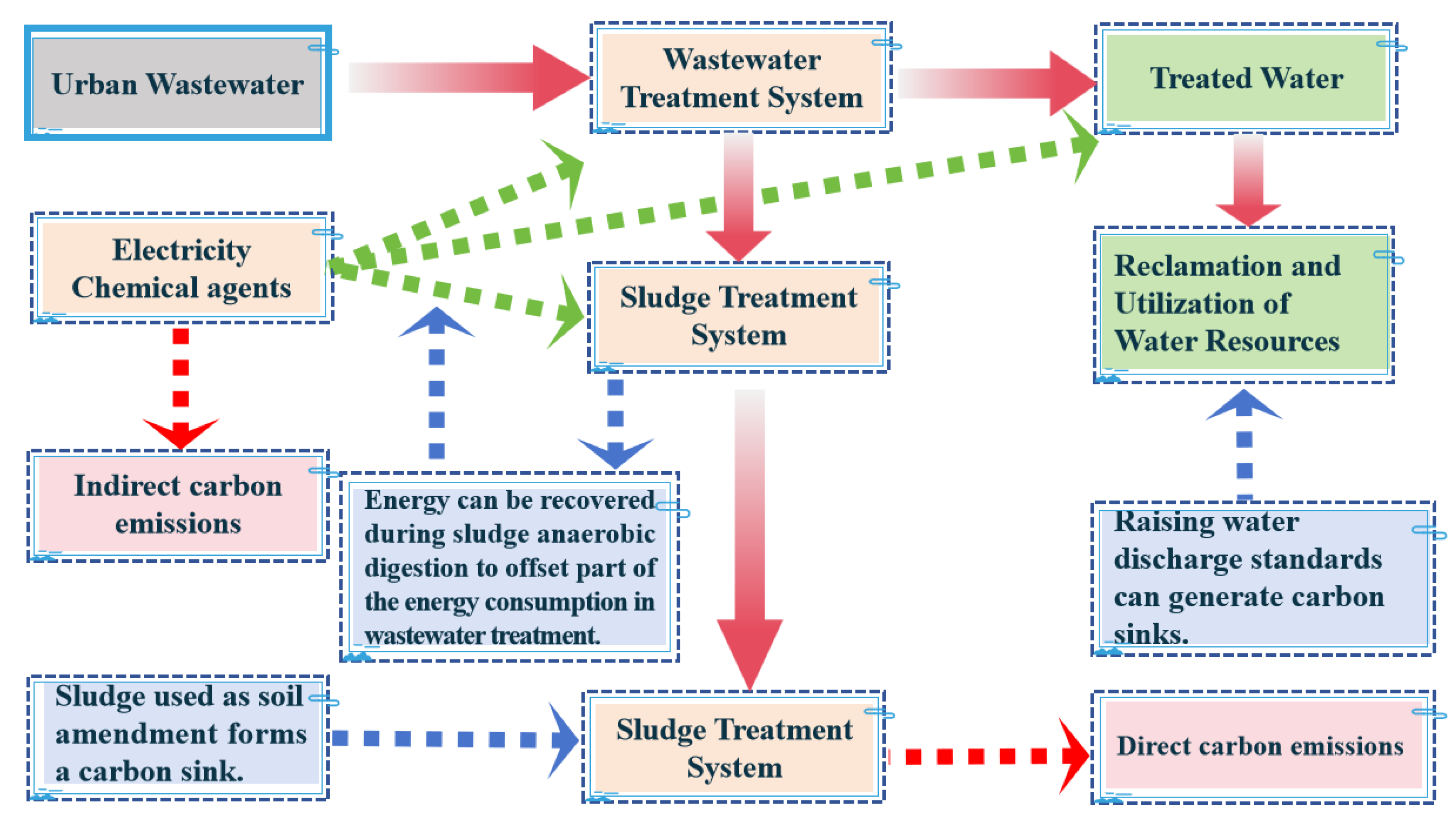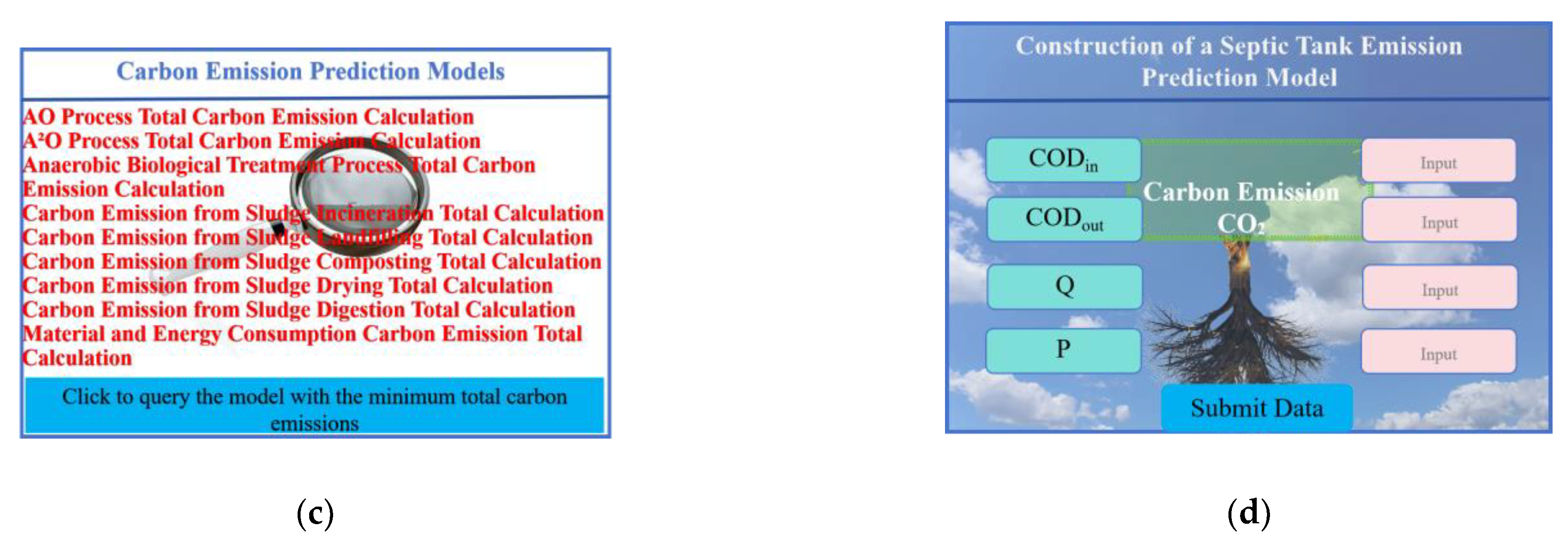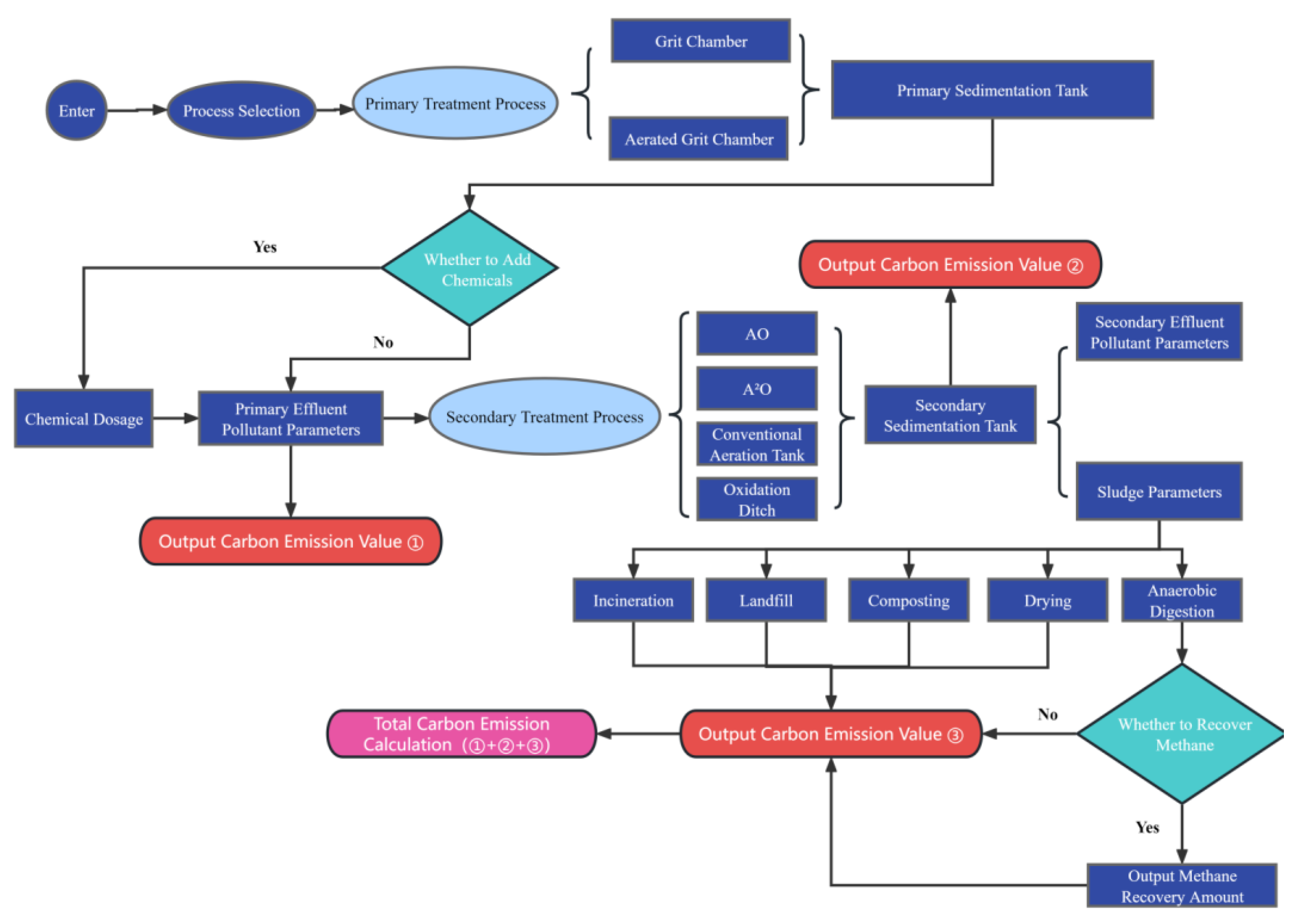1. Introduction
In recent years, environmental issues, particularly global warming, have garnered significant attention from the public and academic communities worldwide. In September 2019, the United Nations Framework Convention on Climate Change (UNFCCC) stated that many countries had pledged to achieve net zero carbon emissions by 2050 [
1]. Carbon emissions primarily refer to greenhouse gases dominated by carbon dioxide (CO
2), including nitrous oxide (N
2O), methane (CH
4), ozone (O
3), and chlorofluorocarbons (CFCs, freons). Existing research data indicate that prolonged and extensive carbon emissions contribute to global warming, rising temperatures, and changes in ecosystems, which in turn affect agricultural production and the growth of flora and fauna [
2,
3,
4,
5]. Additionally, carbon emissions lead to the melting of glaciers and permafrost, rising sea levels, and widespread flooding, exacerbating droughts and causing water resource shortages, ultimately affecting the environment. The reduction of greenhouse gas emissions and response to climate change have become a global consensus within the international community. Most industries (e.g., the power sector, chemical industry, agriculture, and construction industry) are required to conduct carbon emission assessments and formulate strategies for carbon reduction [
6,
7,
8,
9,
10].
As a focal point linking environmental pollution, fossil fuel consumption, and global warming, carbon emissions play a pivotal role in shaping China’s long-term environmental strategies. According to statistics from the World Resources Institute, the major sources of carbon emissions in China are the construction and renewable energy industries, as well as the industrial and agricultural sectors [
11]. China’s main contributors to carbon emissions are energy, industry, transportation, and building materials. In 2021, China’s industrial sector energy consumption (including 41 industrial categories) accounted for about 65.29% of the country’s total energy consumption, of which coal consumption accounted for 54.98%. The industrial sector contributes nearly 76.30% of sulfur dioxide emissions and 67.25% of carbon dioxide emissions to the country’s total emissions [
12]. Since transportation is a primary and essential sector for social development and the national economy, carbon emissions from China’s transportation sector account for 9.17% of the total [
13]. In 2020, the total energy consumption of the entire lifecycle of China’s buildings reached 2.27 billion tonnes of coal equivalent (tce), accounting for 45.5% of China’s total energy consumption. Specifically, the energy consumption during the building materials production stage was 1.11 billion tce, representing 22.3% of the country’s total energy consumption; the energy consumption during the construction stage was 0.09 billion tce, accounting for 1.9%; and the energy consumption during the building operation stage was 1.06 billion tce, making up 21.3%. In the same year, the total carbon emissions from the entire lifecycle of China’s buildings amounted to 5.08 billion tonnes of CO
2, representing 50.9% of the country’s total carbon emissions. Among these, the carbon emissions from the building materials production stage were 2.82 billion tonnes of CO
2, accounting for 28.2% of the total; the carbon emissions from the construction stage were 0.1 billion tonnes of CO
2, representing 1.0%; and the carbon emissions from the building operation stage were 2.16 billion tonnes of CO
2, accounting for 21.7% [
14]. Studies have shown that under low-carbon and carbon-neutral scenarios, measures to improve the efficiency of the building materials value chain have the greatest potential for CO
2 emissions reduction before 2030 and remain significant through 2060 [
15]. In summary, carbon emissions have emerged as a crucial determinant in shaping China’s long-term environmental policies. This issue is central not only to political and international dialogues but also to initiatives aimed at ecological restoration, fossil fuel conservation, and mitigating global warming. Projections indicate that carbon emissions from the wastewater sector are expected to increase by 27% between 2005 and 2030 [
16,
17,
18,
19].
It is worth noting that during the social water cycle, a significant portion of water is converted into domestic sewage and industrial wastewater. These two sources are the primary contributors to water pollution and critical challenges hindering the harmonious development of socio-economic progress and environmental protection [
20,
21,
22,
23]. Traditional wastewater treatment relies on additional energy and chemicals to sustain the high pollutant removal efficiency of microorganisms in biological reaction tanks. These microorganisms break down polymeric organic matter into CO
2, H
2O, and energy [
24]. However, the water treatment industry, as a persistent source of greenhouse gas emissions, has gone largely unnoticed. This was mainly attributed to the hidden and unpredictable nature of greenhouse gas emissions within the sector. Biological wastewater and sludge treatment processes involve a wide variety of microorganisms and complex biochemical reactions, resulting in greenhouse gas emissions that vary significantly depending on environmental conditions. This process involves both direct carbon emissions from biological activities and indirect carbon emissions from the operation of equipment and facilities [
25,
26]. Moreover, these emissions are continuous and long-term. In 2021, the “Innovation and Development of Carbon Reduction Technologies under the Carbon Neutrality Context” forum was held in Beijing, where researchers proposed new directions and pathways for low-carbon development of China’s wastewater treatment industry [
4,
5]. In 2021, the centralized collection rate of urban domestic sewage in China reached 68.6%, representing an increase of 3.8 percentage points compared with the previous year [
27]. By 2025, the wastewater treatment sector is projected to make substantial progress in achieving synergistic outcomes for pollution reduction and carbon mitigation alongside continuous advancements in energy efficiency and carbon reduction capabilities. In addition, water-scarce cities at the prefecture level and above in China are expected to achieve reclaimed water utilization rates exceeding 25% [
28]. In recent years, China will design and construct 100 wastewater treatment plants with efficient energy utilization and resource recovery systems, primarily based on low-carbon emission water treatment technologies [
29]. The country aims to increase this rate to 70% by 2025, with a primary focus on mitigating greenhouse-gas emissions. Existing research has focused on areas such as carbon emission accounting [
30,
31,
32], carbon emission measurement [
23,
33,
34] carbon emission structure [
35,
36] carbon footprint analysis [
37,
38,
39,
40,
41], and carbon emission evaluation [
42]. However, studies utilizing existing wastewater treatment engineering data for simulation and prediction remain relatively scarce.
Foreign experts have long focused on the issue of carbon emissions during the wastewater treatment process and have conducted professional research on this topic. Bridle [
43] developed a program that can be used for wastewater treatment plant data. This program evaluated data from 16 wastewater treatment facilities in Canada, calculating the emissions from primary treatment, conventional activated sludge, extended aeration, and anaerobic digestion of residual sludge. Jennifer R. Stokes et al. [
44] developed the Wastewater Energy Sustainability Tool (WWEST), which is used to conduct a hybrid life cycle assessment of wastewater collection, treatment, and discharge infrastructure in the United States. Christine Sweetapple [
45] revised the activated sludge model and developed BSM2-e (Benchmark Simulation Model No.2-e), which is used to study the sources of uncertainty in greenhouse gas emission modeling during the wastewater treatment process. Hiroko Yoshida [
46] applied tracer dispersion methods to quantify the integrated, real-time emissions of methane and nitrous oxide from a wastewater treatment plant. Shuhei Masuda [
47] and others investigated the seasonal variations of greenhouse gas emissions and the main emission sources at a specific wastewater treatment plant. Celia Somlai et al. [
48] used a multi-chamber automated soil gas flux system with high spatial and temporal resolution to measure CO
2 and CH
4 fluxes for 81 days in septic tanks in the northern maritime climate of Ireland. They studied the spatiotemporal variations of CO
2 and CH
4 emissions from septic tank leachate and found that CO
2 fluxes exhibited strong diurnal variations driven by soil temperature, while CH
4 fluxes were less influenced by environmental factors. These studies and reports focus on accounting for the water treatment facilities and evaluating specific processes or products, but there has been limited research on carbon emission assessment models for the entire wastewater treatment process. Consequently, there is no systematic method for evaluating the carbon emissions of water treatment processes and the energy-saving effects of the processes. In addition, in recent years, there has been widespread attention in the industry regarding carbon emissions measurement and modeling methods in wastewater treatment, such as Multi-Objective Particle Swarm Optimization (MPSO), Non-dominated Sorting Genetic Algorithm-II (NSGA-II) [
49], and Mixed-Integer Programming models [
50].
This study explores the generation mechanisms and transformation pathways of greenhouse gases during the biochemical processes of biological wastewater treatment. By developing a carbon emission prediction model based on biochemical reaction equations, this study quantified the carbon emissions throughout the treatment process. The paper also provides preliminary carbon emission simulation calculations in the process design of newly constructed wastewater treatment plants to assess the energy consumption and environmental impact of the design, and to optimize the wastewater treatment processes and operational modes. The results provide valuable guidance for promoting energy efficiency, reducing emissions, and optimizing processes in biological wastewater treatment systems, offering a scientific basis for sustainable upgrades and innovations in treatment technologies.
4. Discussion
The sewage treatment plant data program by Hugh D. Monteith [
69] and others yielded the following results: the primary treatment discharge rate was 0.005 kg CO
2 equivalent m
−3, the conventional activated sludge rate was 0.26 kg CO
2 equivalent m
−3, and after extended aeration and aerobic digestion, the residual sludge undergoes anaerobic digestion with a discharge rate of 0.8 kgCO
2 equivalent m
−3. An evaluation of the carbon emissions from water treatment at the Xi’an Second Sewage Treatment Plant on 15 May 2024, was conducted, using the plant’s average inflow and outflow parameters for that day. The specific data is as following
Table 6 and
Table 7:
The calculation results of the carbon emission platform are shown in
Table 8.
The carbon emissions of the plant on that day were 162,214.6 kg d−1, with a carbon emission of 0.9 kg CO2 equivalent m−3 per unit of treated water. The direct carbon emissions were 97,996.6 kg d−1, with a carbon emission of 0.54 kg CO2 equivalent m−3 per unit of treated water. Among these, the carbon emissions from biological treatment were 95,948.8 kg d−1, with a carbon emission of 0.53 kg CO2 equivalent m−3 per unit of treated water. The carbon emissions from sludge anaerobic digestion were 2047.8 kg d−1, with a carbon emission of 2.1 kg CO2 equivalent m−3. The indirect carbon emissions were 64,218 kg d−1, with a carbon emission of 0.36 kg CO2 equivalent m−3 per unit of treated water. Among these, the carbon emissions from material consumption were 11,835 kg d−1, with a carbon emission of 0.065 kg CO2 equivalent m−3 per unit of treated water, while the carbon emissions from energy consumption were 52,383 kg d−1, with a carbon emission of 0.29 kg CO2 equivalent m−3 per unit of treated water.
The plant’s carbon emissions for that day were calculated using the IPCC greenhouse gas inventory method. The calculation results are shown in
Table 9.
The carbon emissions calculated using the IPCC greenhouse gas inventory method for this water plant were higher than those calculated by the software, as the carbon emissions from electricity consumption were double-counted, leading to an overestimation of the plant’s overall carbon emissions. This has a certain misleading effect on the plant’s carbon reduction efforts. The results obtained by the software also showed significant differences from the findings of Hugh D. Monteith [
68] and others, primarily because the software system calculates the entire water treatment process.
The effluent from the conventional septic tanks had the following characteristics: COD, 120–400 mg L
−1; BOD
5, 40–150 mg L
−1; COD removal rate, 15%; SS removal rate, 30%; BOD
5 removal rate, 9%; and ammonia nitrogen removal rate, 3%. According to the “Outdoor Drainage Design Code” GB50014-2021 [
70], the BOD
5 of domestic sewage can be calculated as 25 g~50 g per person per day, and based on the B/C ratio of domestic sewage, the average COD is calculated as 75 g per person per day. The “Discharge Standard for Sewage into Urban Sewers” GB/T31962-2015 [
71] requires the discharge limits to be: COD 500 mg L
−1 and BOD
5 350 mg L
−1. With the population of the 100 most populous cities in China being approximately 150 million, a simulation can be performed to predict the daily carbon emissions generated by septic tanks in these cities.
emissions were reported at 420 tons per day, whereas
emissions amounted to 570 tons per day. The total carbon emissions, expressed as greenhouse gas (
) equivalents, reached an estimated 11,000 tons per day. The calculation above only accounts for the 100 most populous cities in China. The population used in the calculation was likely underestimated, with a total of 338 prefecture-level cities in China. In addition, carbon emissions from nitrogen removal were not considered. Furthermore, the calculation only includes carbon emissions from septic tanks associated with residential building wastewater and does not consider septic tanks in other public buildings. Therefore, septic tanks related to building wastewater are underestimated and overlooked as sources of carbon emissions.
5. Conclusions
Based on the sources of carbon emissions and the biochemical reaction equations of biological sewage treatment processes, a carbon emission model was constructed. Using the model, a preliminary carbon emission calculation was performed for typical sewage treatment processes, leading to the following conclusions. For urban sewage with similar water volume and quality, the oxidation ditch process, compared to the A2O process, is more conducive to energy saving and emission reduction, and the carbon emissions from septic tanks associated with buildings exceed 10,000 tons per day. Septic tanks have underestimated and overlooked sources of carbon emissions. The effluent from the septic tank has not undergone a disinfection process, the system is open, and carbon emissions have not yet been recovered, posing potential air environmental hazards, pathogenic risks, and biological threats.
Future efforts should focus on improving the structural design of septic tanks to facilitate gas collection and reduce carbon emissions. Several limitations were identified through the calculation and simulation of carbon emissions from the sewage treatment processes. For instance, there are numerous influencing factors, making it difficult to calculate each factor individually to improve accuracy, and there is a lack of engineering measurement data, making it impossible to assess the deviation between simulated and actual data. Some gases generated during the wastewater treatment process are water-soluble (e.g., CO2, N2O, etc.); when the temperature changes, the solubility of various water-soluble gases in water varies significantly. The model calculation does not account for the carbon emissions from gases dissolved in water, resulting in an overestimation of the direct carbon emissions calculated by the model. The simulation mainly focused on activated sludge-based treatment systems, excluding other ecological treatment technologies. Future research should prioritize studying deviations and collecting more data while also including carbon emissions accounting for ecological treatment systems. The design of sewage treatment processes should not be solely focused on treatment efficiency and meeting discharge standards but should also comprehensively consider environmental impacts, particularly carbon emissions. The application of “Internet+” technologies will make carbon emission calculations for water treatment processes more scientific and accurate. Utilizing big data systems will bring model calculations closer to actual emissions, offering valuable insights into industry standards, engineering design, and system operation.










